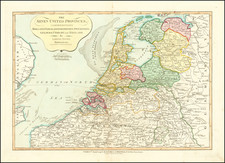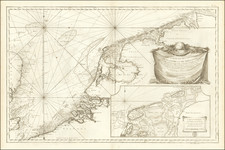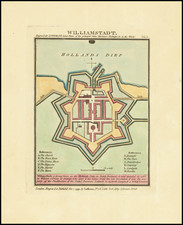Nice example of Braun & Hogenberg's second plan of Amsterdam, showing the significant growth and expansion of the town at the end of the 16th and beginning of the 17th Century.
The following is a translation of the text on the verso:
When Amsterdam passed to the county it was impecunious, but it gradually increased in size and wealth to such an unbelievable extent that it has repeatedly, and for the last time very recently, been extended by more than half. [...] What inexpressible riches are heaped, as it were, on this city. One could say that Amsterdam wants for nothing, except that it has too much wealth. The city is like a store house from which not only neighbouring but also far distant countries are supplied in times of need, like Italy and Spain a few years ago. Here no one is excluded, but participation is open to anyone, of whatever nation or religion, who desires to carry on honest trade.
This city map oriented to the southwest is an update of the view of Amsterdam dating from the first edition, which was first printed in 1572. The updated map It became necessary because of the drastic changes that had taken place since then. In the course of the city's rapid increase in prosperity, resulting not least from the East Indian trade, it was also considerably extended in size.
The Oude Kerk (old church), built before 1300 and converted into a basilica in the 16th century, can be made out, as can the fortifications of 1593, some of the most modern at the time, featuring 12 bastions. In addition, the map documents the extension of the city resolved in 1607, which began with the construction of fortifications in the west; these marked the new boundary of the city, and the planned continuation is indicated in outline.
Georg Braun (1541-1622) was born and died in Cologne. His primary vocation was as Catholic cleric; he spent thirty-seven years as canon and dean at the church St. Maria ad Gradus, in Cologne. Braun was the chief editor of the Civitates orbis terrarum, the greatest book of town views ever published. His job entailed hiring artists, acquiring source material for the maps and views, and writing the text. In this role, he was assisted by Abraham Ortelius. Braun lived into his 80s, and he was the only member of the original team to witness the publication of the sixth volume in 1617.
Frans Hogenberg (ca. 1540-ca. 1590) was a Flemish and German engraver and mapmaker who also painted. He was born in Mechelen, south of Antwerp, the son of wood engraver and etcher Nicolas Hogenberg. Together with his father, brother (Remigius), uncle, and cousins, Frans was one member of a prominent artistic family in the Netherlands.
During the 1550s, Frans worked in Antwerp with the famous mapmaker Abraham Ortelius. There, he engraved the maps for Ortelius’ groundbreaking first atlas, published in Antwerp in 1570, along with Johannes van Deotecum and Ambrosius and Ferdinand Arsenius. It is suspected he engraved the title page as well. Later, Ortelius supported Hogenberg with information for a different project, the Civitates orbis terrarium (edited by Georg Braun, engraved by Hogenberg, published in six volumes, Cologne, 1572-1617). Hogenberg engraved the majority of the work’s 546 prospects and views.
It is possible that Frans spent some time in England while fleeing from religious persecution, but he was living and working in Cologne by 1580. That is the city where he died around 1590. In addition to his maps, he is known for his historical allegories and portraits. His brother, Remigius, also went on to some fame as an engraver, and he died around the same time as his brother.









![[Low Countries ] Belgium Foederatum emendate auctum et novissime editum](https://storage.googleapis.com/raremaps/img/small/98432.jpg)

![[Proposed Canal / Utrecht to the Sea] Nieuwe en Nette Aftekening van de Door Gravinge die er staat te Geschieden beginnende van de Stadt Utrecht to aan Spakenborg in de Zuyder Zee met des zelfs Afbakinge &c](https://storage.googleapis.com/raremaps/img/small/94380.jpg)
![[Rhine River] Nova Totius Rheni Descriptio ex celeberrimis et varijs Autoribus, in unam tabulam redacta . . . 1672](https://storage.googleapis.com/raremaps/img/small/62395.jpg)

